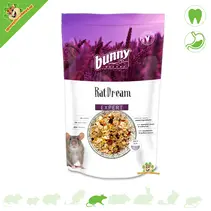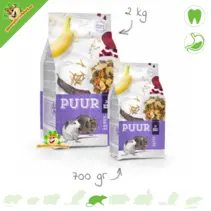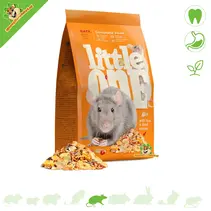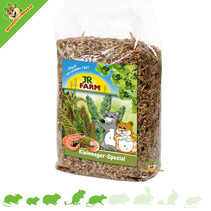Rat Food for Tame Rats – Complete Food, Mixes & Chunks + Feeding with a Twist
- Voor 17 uur besteld, dezelfde dag verzonden!
- Specialist sinds 2011
- Delivery from our own stock

Rat food – complete food for pet rats, with room for smart foraging
 Good rat food is the foundation for an active, stable group: energy, good physical condition, and a daily routine that works in practice. In this category, you'll find rat food for pet rats in two popular options: complete pellets/chunks (convenient and clear) and natural mixes (varied and fun for foraging).
Good rat food is the foundation for an active, stable group: energy, good physical condition, and a daily routine that works in practice. In this category, you'll find rat food for pet rats in two popular options: complete pellets/chunks (convenient and clear) and natural mixes (varied and fun for foraging).
Rats are smart and often critical: the goal is to find a diet they enjoy, but one that also remains balanced for the entire group. That's why we offer practical selection guidance below (without complicated theory). DRD Rodent Shop ® – Specialist in rodents and rabbits since 2011.
Chunks provide clarity and help limit selective feeding. Mixed feeds are great if you dose and combine them wisely.
Rat chunks→
Rats love a challenge. Foraging turns eating into an activity and prevents boredom.
Play & Forage →
Multiple rats? Choose feeding areas that are peaceful. Extra bowls help with groups (less fuss around food).
Rat food bowls →
Choosing rat food – quick selection guide
Want to keep things simple and consistent ? Then choose a complete rat pellet/kibble as a base. Do you value variety (and do you like foraging)? Then a natural mix is a good option, provided you control the amount and avoid only eating "favorites."
1) Pellets / all-in-one chunks (clear and convenient)
- Suitable if you want less selection behaviour and are looking for a stable base.
- Practical for groups: each rat receives a comparable amount.
2) Natural mixes (variety & fun for foraging)
- Ideal for scattering and hiding: search and work for your food.
- Tip: give a mix in appropriate portions and check whether everything is eaten (not just the “tastiest” parts).
✔ Not sure? Combining the two is often easiest: pellets as a base and a small portion of mix/extras as enrichment.
What types of rat food can you find in this category?
- Complete rat pellets / rat chunks – solid base, useful for groups.
- Mixed/muesli-style rat food – varied, fun to scatter and forage.
- Add-ons – consider suitable extras for variety, such as herbs & seeds or snacks (always in moderation).
Feeding routine that works with a group (practical & calm)
- Multiple feeding stations help with groups: less pressure around one bowl.
- Keep it measurable : give fixed portions and see if anything is consistently left behind.
- Always combine with fresh water (bottle or bowl): drinking bottles & water bowls .
Feeding = enrichment: how to turn eating into an activity
Rats are intelligent problem solvers. With small adjustments, you can make feeding more fun without making it "too difficult":
- Scattering : distribute part of the daily ration throughout the enclosure (not in toilet areas).
- Hiding : a small area in a tunnel, hammock edge, or foraging toy.
- Rotate : Change 1–2 feeding routes per week; this keeps things interesting and manageable.
Looking for foraging items that are truly "rat-proof"? Then check out Rats Playing & Foraging .
Storage & hygiene: how to keep rat food fresh
- Store food in a dry , cool place and tightly closed (preferably in a storage container).
- Check regularly for crumbs/moisture in the bag or container (this prevents spoilage).
- Do you see "flour/dust" or web-like threads in the food? Clean up immediately and replace the food.
Checklist – Choosing and Feeding Rat Food (Short and Clear)
✔ Choose a clear base (pellet/chunk or mix with a good routine).
✔ Avoid “favorites only”: check if everything is eaten.
✔ Multiple rats? Use multiple feeding stations for rest.
✔ Make feeding fun: sprinkle/hide part of the portion.
✔ Always fresh water available.
Safety
It's best to change food gradually (especially with sensitive animals) and observe your group for the first few days: appetite, behavior, and stool. If problems persist or you have any doubts, it's wise to consult a veterinarian (or rodent specialist).
FAQ – rat food
What's better: rat pellets or a mix?
Pellets/chunks are often the most organized (less selective behavior). Mixes are great for foraging, but be smart about the amount and check if everything is eaten.
How do I prevent hassles around food in a group?
Use multiple feeding stations and offer (some of) the food in a staggered manner. This way, lower-ranking animals also have undisturbed access.
Can I give extras such as vegetables or fruit?
Many rats enjoy small treats, but keep them limited and within the total daily ration. If you see the basic food being left behind, it's time to cut back.
What is a fun “must have” besides basic food?
Forage enrichment. See Play & Forage and combine with snacks (in moderation).
✔ Complete rat food: pellets/chunks and natural mixes
✔ Smart tips for feeding in a group (peace and overview)
✔ Specialist since 2011
Order before 5 PM, shipped the same day | Delivered from our own stock | Specialist since 2011


















